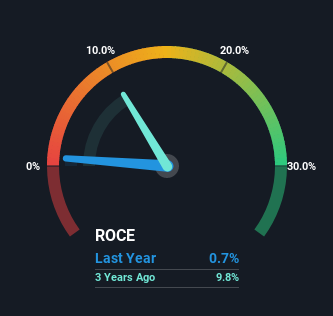[ad_1]
When researching a stock for investment, what can tell us that the company is in decline? More often than not, we’ll see a declining return on capital employed (ROCE) and a declining amount of capital employed. Basically the company is earning less on its investments and it is also reducing its total assets. And from a first read, things don’t look too good at Springs Global Participações (BVMF:SGPS3), so let’s see why.
Return On Capital Employed (ROCE): What Is It?
For those who don’t know, ROCE is a measure of a company’s yearly pre-tax profit (its return), relative to the capital employed in the business. To calculate this metric for Springs Global Participações, this is the formula:
Return on Capital Employed = Earnings Before Interest and Tax (EBIT) ÷ (Total Assets – Current Liabilities)
0.0072 = R$12m ÷ (R$3.1b – R$1.4b) (Based on the trailing twelve months to June 2022).
So, Springs Global Participações has an ROCE of 0.7%. In absolute terms, that’s a low return and it also under-performs the Consumer Durables industry average of 6.0%.
See our latest analysis for Springs Global Participações

While the past is not representative of the future, it can be helpful to know how a company has performed historically, which is why we have this chart above. If you want to delve into the historical earnings, revenue and cash flow of Springs Global Participações, check out these free graphs here.
What The Trend Of ROCE Can Tell Us
There is reason to be cautious about Springs Global Participações, given the returns are trending downwards. About five years ago, returns on capital were 9.1%, however they’re now substantially lower than that as we saw above. Meanwhile, capital employed in the business has stayed roughly the flat over the period. This combination can be indicative of a mature business that still has areas to deploy capital, but the returns received aren’t as high due potentially to new competition or smaller margins. If these trends continue, we wouldn’t expect Springs Global Participações to turn into a multi-bagger.
On a side note, Springs Global Participações’ current liabilities have increased over the last five years to 46% of total assets, effectively distorting the ROCE to some degree. If current liabilities hadn’t increased as much as they did, the ROCE could actually be even lower. What this means is that in reality, a rather large portion of the business is being funded by the likes of the company’s suppliers or short-term creditors, which can bring some risks of its own.
The Key Takeaway
In the end, the trend of lower returns on the same amount of capital isn’t typically an indication that we’re looking at a growth stock. This could explain why the stock has sunk a total of 78% in the last five years. Unless there is a shift to a more positive trajectory in these metrics, we would look elsewhere.
If you’d like to know more about Springs Global Participações, we’ve spotted 3 warning signs, and 2 of them are a bit unpleasant.
If you want to search for solid companies with great earnings, check out this free list of companies with good balance sheets and impressive returns on equity.
Have feedback on this article? Concerned about the content? Get in touch with us directly. Alternatively, email editorial-team (at) simplywallst.com.
This article by Simply Wall St is general in nature. We provide commentary based on historical data and analyst forecasts only using an unbiased methodology and our articles are not intended to be financial advice. It does not constitute a recommendation to buy or sell any stock, and does not take account of your objectives, or your financial situation. We aim to bring you long-term focused analysis driven by fundamental data. Note that our analysis may not factor in the latest price-sensitive company announcements or qualitative material. Simply Wall St has no position in any stocks mentioned.
Discounted cash flow calculation for every stock
Simply Wall St does a detailed discounted cash flow calculation every 6 hours for every stock on the market, so if you want to find the intrinsic value of any company just search here. It’s FREE.
[ad_2]
Source link








